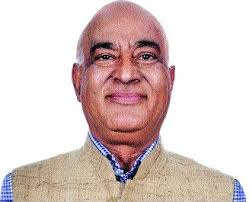Synchronised elections, voter behaviour, and governance outcomes
An active policy proposal of the Government of India is to hold national elections at the same time as the assembly elections of all the states. This article examines whether holding national and stat...
-
 Vimal Balasubramaniam
Vimal Balasubramaniam  Sabyasachi Das
Sabyasachi Das  Apurav Yash Bhatiya
Apurav Yash Bhatiya  28 August, 2020
28 August, 2020
- Articles
Political determinants of newspaper markets in India
Newspapers are an important source of political information for Indian voters. This article looks at how political factors influence the newspaper market. Using the announcement of delimitation in the...
-
 Julia Cagé
Julia Cagé  Guilhem Cassan
Guilhem Cassan  Francesca R. Jensenius
Francesca R. Jensenius  23 November, 2023
23 November, 2023
- Articles
A proposal for public funding of elections and political parties in India
The Finance Minister of India recently introduced measures aimed at cleaning up political party funding in the country. In this article, Gowda and Santhosh highlight the limitations of these measures,...
-
 M.V. Rajeev Gowda
M.V. Rajeev Gowda  Varun Santhosh
Varun Santhosh  21 April, 2017
21 April, 2017
- Perspectives
How leader identity impacts group coordination
In principle, leaders can facilitate group coordination towards a common goal but in diverse societies, their effectiveness may depend upon their social identity, and how citizens react to leader iden...
-
 Sonia Bhalotra
Sonia Bhalotra  Irma Clots-Figueras
Irma Clots-Figueras  Lakshmi Iyer
Lakshmi Iyer  Joseph Vecci
Joseph Vecci  22 October, 2018
22 October, 2018
- Articles
Heart of darkness: Misplaced priorities of Jharkhand’s District Mineral Foundation
In 2015, the central government launched District Mineral Foundations in the districts affected by mining, which are mandated to collect royalty from all mining activities and use the funds for the we...
-
 Arindam Banerjee
Arindam Banerjee  Aditya Ranjan
Aditya Ranjan  08 October, 2018
08 October, 2018
- Notes from the Field
The Impact of Community-Driven Accountability on Land Rights Governance: Evidence from a Homestead Land Titling Initiative
How and under what circumstances can civic mobilization improve local governance and service delivery? This project seeks to contribute to debates on this question through a multi-method analysis of a...
-
 Sanjay Kumar
Sanjay Kumar  Andre Nickow
Andre Nickow  30 September, 2018
30 September, 2018
- IGC Research on India
Judicial Institutions and Economic Development: Examining Micro-evidence from India
This project examines the relationship between a country’s legal environment and its economic outcomes. This project will be constructing relevant measures of friction from trial level data at subor...
-
 Aprajit Mahajan
Aprajit Mahajan  30 September, 2018
30 September, 2018
- IGC Research on India
Do Indian voters mind their representatives getting rich in office?
Asset declarations, requiring politicians to disclose their financial information, are becoming increasingly common across the world. In India, financial declarations are part of public affidavits fil...
-
 Simon Chauchard
Simon Chauchard  S.P. Harish
S.P. Harish  Marko Klašnja
Marko Klašnja  10 August, 2018
10 August, 2018
- Articles
How governance and public expenditure impact human development
The state of Madhya Pradesh displays wide variance in human development outcomes across its districts. This article examines the link between public expenditure, quality of governance, and human devel...
-
 N. R. Bhanumurthy
N. R. Bhanumurthy  Richa Jain
Richa Jain  Manish Kumar Prasad
Manish Kumar Prasad  01 August, 2018
01 August, 2018
- Articles
Do dishonest people gravitate towards the public sector in India?
The corruption level in the public sector may not only depend on punishments and systems put in place to deter corruption, but also on who chooses to enter the sector. This article finds that people w...
-
 Rema Hanna
Rema Hanna  Shing-Yi Wang
Shing-Yi Wang  30 July, 2018
30 July, 2018
- Articles
The strategic logic of money flows in Indian elections
Why do political candidates give voters handouts during election campaigns, even when they are unable to monitor voter behaviour? Based on a qualitative study in Mumbai, this article argues that compe...
-
 Simon Chauchard
Simon Chauchard  16 July, 2018
16 July, 2018
- Articles
Protecting data privacy: Authorisation and access control
The B.N. Srikrishna Committee, which was constituted in August 2017 to draft India’s data protection laws, is expected to submit its final recommendations this month. In this post, Banerjee and Shar...
-
 Subhashis Banerjee
Subhashis Banerjee  Subodh V. Sharma
Subodh V. Sharma  04 July, 2018
04 July, 2018
- Perspectives
Sunlight as disinfectant: Disclosure requirements and corruption in India
It is believed that transparency and free access to information can root out corruption and malfeasance in government. This article finds that the introduction of asset disclosure rules for candidates...
-
 Raymond Fisman
Raymond Fisman  22 June, 2018
22 June, 2018
- Articles
Enfranchising your own? Polling officer identity and electoral outcomes
The provision of free and fair elections is a public service critical to maintaining accountability and responsiveness of elected officials. This article examines the administration of polling station...
-
 Yusuf Neggers
Yusuf Neggers  20 June, 2018
20 June, 2018
- Articles
Election by community consensus: Effects on political selection and governance
Multiple states in India incentivise village communities to elect their political representatives by community consensus, doing away with the need for state governments to organise official secret bal...
-
 Ashna Arora
Ashna Arora  21 May, 2018
21 May, 2018
- Articles
Twitter feed
Tweets by Ideas4IndiaMost Popular Governance Posts
Unique Health Identification and Aadhaar: A case for mandatory linkage
As part of the Digital India initiative, All India Institute of Medical Sciences (AIIMS) issues a Unique Health Identification (UHID) number to each patient, which documents their entire journey in th...
 Mudit Kapoor
Mudit Kapoor  23 December, 2016
23 December, 2016
- Perspectives
Caste dominance in rural India: Cause and effect
Rural India remains a caste-based society. This column explores why caste continues to play such an important role and what the effects are. It argues that trade and agricultural productivity suffer, ...
 Siwan Anderson
Siwan Anderson  16 August, 2012
16 August, 2012
- Articles
Why did the Indian economy stagnate under the colonial rule?
How did the Indian economy fare under the colonial rule? Is the average Indian significantly better off after Independence? This column examines trends in GDP per capita in order to determine the stan...
 Aniruddha Bagchi
Aniruddha Bagchi  16 September, 2013
16 September, 2013
- Articles





 16 November, 2023
16 November, 2023






